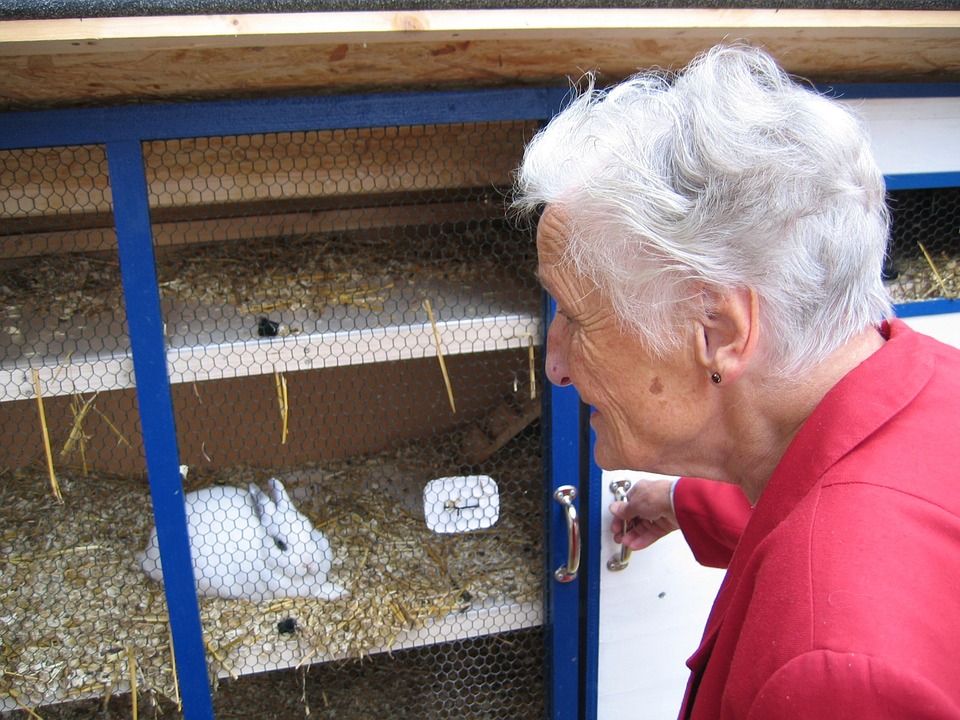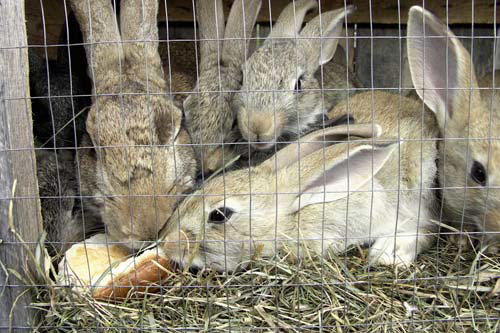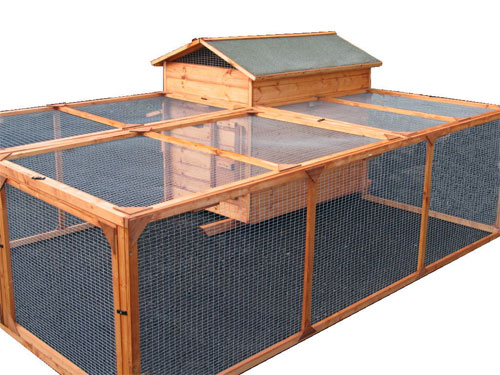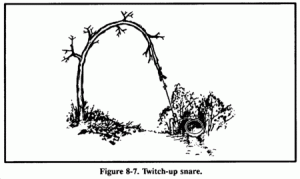Backyard Rabbit Keeping, Part 1/15 – Why Keep Rabbits?
 This article is meant to be an introduction to the prospect of raising rabbits on a small scale for personal use (and perhaps a bit more). We’ll be starting by outlining the generalities. If you’re interested, watch for more detailed articles to follow in our 15 part series. Considering subscribing to our site using the RSS feed icon at the top of every page. Thanks and enjoy!
This article is meant to be an introduction to the prospect of raising rabbits on a small scale for personal use (and perhaps a bit more). We’ll be starting by outlining the generalities. If you’re interested, watch for more detailed articles to follow in our 15 part series. Considering subscribing to our site using the RSS feed icon at the top of every page. Thanks and enjoy!
Rabbits are a very good means of starting backyarding. If you have never kept animals and have literally nothing larger than a backyard, you can still achieve a certain enjoyable independence by producing your own meat from rabbits. You can rediscover the taste of real meat, produced without the aid of drugs and growth stimulants, such as anabolic steroids, which are fed to some of our farm animals now. Rabbit meat is versatile in that there are many ways of serving it. Your surplus can be exchanged for different produce from other back-yarders – once you start, you are bound to meet like minded people. There is great satisfaction in growing your own food and sidestepping the dreary circle of factory farming and supermarket products.
Additionally, home-produced food saves you tax. If you have not bought the food, no taxed income has changed hands and, if you are clever with your rabbits, much of their food can be found without money changing hands. Some can be gathered from the wild, some may be grown and then there is the old cottager’s standby, the barter system. By avoiding the use of money where possible, you reduce the amount that you need to earn without affecting your standard of living. In these ways you will have beaten the system and done something for yourself.
From the age of two months, a litter of rabbits can be ready for the table – a little longer perhaps on our more natural system, but commercial rabbit keepers produce a ‘crop’ in nine or ten weeks. These are fed on pellets made by feed firms, but your rabbits can be reared economically on household scraps and green-food alone. Any walks or expeditions can be given a practical purpose – that of finding fresh grass and plants for the rabbits. With practice you will discover where to look and what they like to eat best.
Rabbit meat is very underrated. It is lean, with very little fat and little waste, and has a high meat to bone ratio. The cholesterol level is low, so it can be classed as a ‘health food’ if produced on a natural diet. If ever this country goes short of meat, rabbits will be the answer.

Consumption of rabbit meat in Britain is estimated at about 1/2 lb per head per year; in 1950 it was 6 lb per head, so you will see that rabbits have gone out of fashion. We may as well face facts straight away; it seems that Myxomatosis, the disease which hit British wild rabbits in 1954, put people off rabbit for good. Ask anybody whether they eat rabbit and usually the subject comes up. It is a pity, because there is no reason why the disease, horrible though it is, should put people off healthy rabbits – and there is absolutely no danger of getting a ‘myxi’ rabbit without knowing it. In Europe, where Myxomatosis also occurred, things are different. The French eat about 14 lb of rabbit meat per head in a year, and the Italians 16 lb.
To me it seems stupid that most of the rabbit meat eaten is imported from Australia or China. And nearly all the rabbit meat they handle is exported to Europe. This would seem to work against the possibility of fresh food ever reaching the consumer; perhaps it also explains the unpopularity of this very good meat!
These are the advantages of home production of rabbit:
- Rabbits are small – this is a great help to a beginner! They are easy to handle and usually docile, although they can scratch. Being small, they mature very quickly. A doe produces a litter in one month and between two and three months later this litter will be ready for the table. With larger types of livestock, you have to wait much longer for results.
- You don’t need a sizable garden to be able to keep rabbits. Hutches can be kept in a small backyard. If the rabbits are well cared for, they will not give rise to unpleasant smells. You can still find free food for them on country walks or even in forgotten corners of towns. The quantities of food they eat may seem large at first, but you are dealing with much less bulk than for pigs or goats.
- The capital outlay, we found, was not too frightening. Look for existing rabbit-rearers in local farmers and trade publications or your nearest Craigslist.org locale. Insist on seeing the conditions your potential rabbits are kept (from clutch to harvest). In general, your best bet is to buy from someone that raises and consumes small-scale like you plan to. Do not but pet rabbits!
- The hutches will of course cost you less if you can make them yourself. During the war they were often made from packing cases. Making nest boxes and hay racks is a great test of ingenuity and it is somehow most satisfying to make something useful yourself, especially if you can do it from second-hand materials. Add to this the cost of drinkers and food troughs, which can also be made from wood, and that is all you need to start with.
- The rabbit is an economical producer of protein and the best one for cheap protein. They will, of course, grow faster on expensive commercial food, but the meat will be cheaper and will probably taste better if most of the food is free. A doe can have six or seven litters a year and should raise 6-8 youngsters each time. The number she produces in a year will depend on the breed and the age of the doe, and also on conditions – it is more difficult to get them to breed in winter if they are housed outdoors. At a dead weight (dressed) for each rabbit of 2 to 3¼ lb, this means that a doe can produce as much meat in a year as a sheep with one lamb. Backyarders can expect fewer litters than commercial breeders, but even so, the prospects are good! Rabbit meat is also available in smaller quantities at a time than pork or lamb, which can be an advantage. You will not need to freeze it, but it will freeze very well if necessary.
- If you have a garden, many of your rabbit feeding problems will be solved; they can eat waste vegetables, weeds and anything left over – or you can grow them food. In return, the manure from your rabbits will be a valuable organic fertilizer, to be used fresh or rotted. In some places an interesting profitable sideline is the production of worms for fishermen from rabbit manure.
- All breeds of rabbit produce fur except the Angora, which bears wool (we will deal with this later). Some breeds have been developed specially for their fur and you can take self-sufficiency a stage further and obtain clothing from the backyard enterprise. The dense velvet fur of Rex rabbits is excellent for gloves. The hair of Rex rabbits is only half an inch long; it is dense, soft and silky.
- There is a great deal of interest in keeping rabbits. It is a practical hobby with the advantage that it saves money by cutting down your butchers’ bills. If you get really keen you may decide to try your hand at showing. In the rabbit world there are real enthusiasts. They meet at rabbit shows, and in the rabbit tent at agricultural shows. A lot of them are townsmen who find in rabbits an outlet for their interest in animals. There is not a great deal of money to be made out of showing, unless you happen to be lucky. But by showing you will get to know other people who are interested, they will see your stock and it will then be easier for you to sell surplus rabbits for breeding.
This section would not be complete without considering the other side of the picture – the drawbacks to embarking on a program of rabbit keeping. What are the disadvantages?
The main problem is one which is common to all livestock keepers; the very regularity of the job. You cannot go away, even for a weekend, and leave animals unattended. What about the holidays? Whose job will it be in any case to feed and clean out the rabbits? It really needs a family conference to decide how the jobs should be shared. The everyday work can be done by children of nine or ten and they can become very interested in rabbit keeping. But sometimes they get bored with the routine and if you are busy yourself, there could be a difficulty. A sensible rotation dividing up the work will perhaps prevent this. As to the holidays, another family might be persuaded to help with the rabbits in exchange for manure or meat.
The work involved is not very much; they can be cleaned out once or twice a week. But of course they must have regular meals and be watched to see that they are in good health; and sometimes they can be allowed out for exercise. The biggest job may well be collecting green-food if you live in a town, but to us this really was the most enjoyable part.
 Mention of cleaning out the rabbits brings us to the problem of smell. Will the rabbits annoy the neighbors or encourage flies? This of course depends on you. There is quite a strong smell from rabbit urine, and if the hutches are left for more than a week without cleaning, there will be a rabbit odor in the air. It is not really unpleasant; the dung pellets are solid, and the wet can be absorbed by bedding. But even with care you may receive complaints when people get to know that you are keeping rabbits. Give the neighbors some of your produce – preferably some manure for the garden, so that the smell will be spread a little! Some people are so far from natural things that they may dislike the idea of rabbits as neighbors; but if you explain what you are doing, they will quite often discover an interest – or their children will.
Mention of cleaning out the rabbits brings us to the problem of smell. Will the rabbits annoy the neighbors or encourage flies? This of course depends on you. There is quite a strong smell from rabbit urine, and if the hutches are left for more than a week without cleaning, there will be a rabbit odor in the air. It is not really unpleasant; the dung pellets are solid, and the wet can be absorbed by bedding. But even with care you may receive complaints when people get to know that you are keeping rabbits. Give the neighbors some of your produce – preferably some manure for the garden, so that the smell will be spread a little! Some people are so far from natural things that they may dislike the idea of rabbits as neighbors; but if you explain what you are doing, they will quite often discover an interest – or their children will.
Perhaps the worst thing about a family livestock enterprise at first, is the idea of killing and eating the animals you have reared. But be assured you will get used to it. It is a problem, but there are ways to minimize it. If you start off with a young doe, rear her and breed from her, she will be the animal you will get to know, and her litters will come and go so quickly there won’t be too much bother. There is in fact a succession of baby rabbits; the older ones can fade into the background before being eaten. With a collection of animals the arrival and departure of individuals is not so traumatic as that of a pet.
Killing and dressing rabbits for the table is an easily acquired skill. There are many countrymen who could show you – many of them are skilled at dealing with wild rabbits. So could many older housewives. With the larger animals there is a trip to the abattoir and you have to pay to get the job done. Rabbits can be killed at home. This is quite legal unless you intend to sell the meat, in which case the premises have to be approved. They do not suffer, and if you have given them a pleasant life, you will have no guilty feelings about it.
I hope that this section has made you want to try rabbit keeping; in the following articles we will consider these various aspects in more detail:
- Why Why Keep Rabbits?
- Rabbits Past and Present
- Some Basic Information
- Making a Start
- Housing
- Feeding
- Growing Crops for Rabbits
- Breeding
- Health
- Harvesting the Wild Rabbits
- The Harvest
- Using Rabbit Meat
- Fur Production
- Showing
- Angoras
Further Research:
   |





Leave a Reply